Statistical Meta-Analysis of Risk Factors for Endometrial Cancer and Development of a Risk Prediction Model Using an Artificial Neural Network Algorithm
Abstract
Simple Summary
Abstract
1. Introduction
Preventive Measures According to Cancer Research UK
2. Methods
2.1. Meta-Analysis and Determination of Pooled Risk
| Inclusion Criteria | Exclusion Criteria |
| Endometrial cancer Risk factors Women Publication dates 2003–2019 English language | Other cancers Lynch syndrome Other genetics/gene mutations Mortality risks Nonhuman <2003 Non-English Reviews without data Case reports Letters, news, notes, commentaries, and editorials Conference abstracts Book chapters Family history |
- Obesity—BMI/anthropometry,
- Diabetes—including IGT (impaired glucose tolerance),
- Parity,
- PCOS,
- HRT,
- Contraceptives.
- Not enough published data to perform analysis,
- No/poor controls in study design,
- Numbers too small (<15),
- Old datasets—not relevant to current clinical management,
- Heterogeneous data,
- Combined risk factor data only (unable to analyze risk factors individually).
2.2. Design and Implementation of a Computational Risk Prediction Model
2.3. Risk Factors RStudio Code
2.4. Neural Network RStudio Code
2.5. Datasets
3. Results
3.1. Training the Software Model to Correlate Percentage Risk with Diagnosis
3.2. Evaluation of the Model’s Ability to Correctly Predict Diagnosis
| > table(actual, prediction) | |||
| prediction | |||
| 0 | 1 | ||
| actual | 0 | 349 | 3 |
| 1 | 2 | 9 | |
4. Conclusions
Supplementary Materials
Author Contributions
Funding
Institutional Review Board Statement
Informed Consent Statement
Data Availability Statement
Acknowledgments
Conflicts of Interest
References
- Cancer Research UK. Uterine (Womb) Cancer Incidence Statistics. Cancer Stats: Cancer Statistics for the UK. Available online: https://www.cancerresearchuk.org/health-professional/cancer-statistics/statistics-by-cancer-type/uterine-cancer/inci-dence?_gl=1*d8jajt*_ga*MTE0NTI5NTI2MC4xNjI0NTIzODU2*_ga_58736Z2GNN*MTYyNDUyMzg1NS4xLjEuMTYyNDUyMzg5Ni4xOQ. &_ga=2.84376858.2070757805.1624523856-1145295260.1624523856 (accessed on 24 June 2021).
- Sonoda, Y.; Barakat, R.R. Screening and the prevention of gynecologic cancer: Endometrial cancer. Best Pract. Res. Clin. Obstet. Gynaecol. 2006, 20, 363–377. [Google Scholar] [CrossRef] [PubMed]
- Pecorelli, S.; Pasinetti, B.; Angioli, R.; Favalli, G.; Odicino, F. Systemic therapy for gynecological neo-plasms: Ovary, cervix, and endometrium. Cancer Chemother. Biol. Response Modif. 2005, 22, 515. [Google Scholar]
- Kitson, S.J.; Evans, D.G.; Crosbie, E.J. Identifying high-risk women for endometrial cancer prevention strategies: Proposal of an endometrial cancer risk prediction model. Cancer Prev. Res. 2017, 10, 1–13. [Google Scholar] [CrossRef]
- Reeves, G.K.; Pirie, K.; Beral, V.; Green, J.; Spencer, E.; Bull, D. Cancer incidence and mortality in relation to body mass index in the Million Women Study: Cohort study. BMJ 2007, 335, 1134. [Google Scholar] [CrossRef]
- Renehan, A.G.; Tyson, M.; Egger, M.; Heller, R.F.; Zwahlen, M. Body-mass index and incidence of cancer: A systematic review and me-ta-analysis of prospective observational studies. Lancet 2008, 371, 569–578. [Google Scholar] [CrossRef]
- Zhou, B.; Yang, L.; Sun, Q.; Cong, R.; Gu, H.; Tang, N.; Wang, B. Cigarette smoking and the risk of endometrial cancer: A meta-analysis. Am. J. Med. 2008, 121, 501–508. [Google Scholar] [CrossRef] [PubMed]
- American Cancer Society. Endometrial Cancer Causes, Risk Factors, and Prevention. Available online: https://www.cancer.org/content/dam/CRC/PDF/Public/8610.00.pdf (accessed on 15 April 2021).
- Dossus, L.; Allen, N.; Kaaks, R.; Bakken, K.; Lund, E.; Tjonneland, A.; Olsen, A.; Overvad, K.; Clavel-Chapelon, F.; Fournier, A.; et al. Reproductive risk factors and endometrial cancer: The European Prospective Investigation into Cancer and Nutrition. Int. J. Cancer 2010, 127, 442–451. [Google Scholar] [CrossRef]
- Hardiman, P.; Pillay, O.S.; Atiomo, W. Polycystic ovary syndrome and endometrial carcinoma. Lancet 2003, 361, 1810–1812. [Google Scholar] [CrossRef]
- Sjögren, L.L.; Mørch, L.S.; Løkkegaard, E. Hormone replacement therapy and the risk of endometrial cancer: A systematic review. Maturitas 2016, 91, 25–35. [Google Scholar] [CrossRef]
- Cancer Research UK: Uterine Cancer Statistics. Available online: https://www.cancerresearchuk.org/health-professional/cancer-statistics/statisticsby-cancer-type/uterine-cancer#heading-Zero (accessed on 15 April 2021).
- Filomeno, M.; Bosetti, C.; Bidoli, E.; Levi, F.; Serraino, D.; Montella, M.; La Vecchia, C.; Tavani, A. Mediterranean diet and risk of endometrial cancer: A pooled analysis of three italian case-control studies. Br. J. Cancer 2015, 112, 1816–1821. [Google Scholar] [CrossRef]
- Sikarin, U.; Sanguankeo, A. Bariatric surgery and risk of postoperative endometrial cancer: A systematic re-view and meta-analysis. Surg. Obes. Relat. Dis. 2015, 11, 949–955. [Google Scholar]
- Tseng, C.-H. Metformin and endometrial cancer risk in Chinese women with type 2 diabetes mellitus in Taiwan. Gynecol. Oncol. 2015, 138, 147–153. [Google Scholar] [CrossRef] [PubMed]
- Meireles, C.G.; Pereira, S.A.; Valadares, L.P.; Rego, D.F.; Simeoni, L.A.; Guerra, E.N.S.; Lofrani-Porto, A. Effects of metformin on endometrial cancer: Systematic review and meta-analysis. Gynecol. Oncol. 2017, 147, 167. [Google Scholar] [CrossRef]
- Cruz, J.A.; Wishart, D.S. Applications of Machine Learning in Cancer Prediction and Prognosis. Cancer Inform. 2006, 2, 59–77. [Google Scholar] [CrossRef]
- Islam, M.M.; Poly, T.A. Machine Learning Models of Breast Cancer Risk Prediction. bioRxiv 2019. [Google Scholar] [CrossRef]
- Banks, E. Endometrial cancer and hormone-replacement therapy in the Million Women Study. Lancet 2005, 365, 1543–1551. [Google Scholar] [CrossRef]
- Gierisch, J.M.; Coeytau, R.R.; Urrutia, R.P.; Havirilesky, L.J.; Moorman, P.G.; Lowery, W.J.; Dinan, M.; McBroom, A.J.; Hasselblad, V.; Sanders, G.D.; et al. Oral ContraceptiveUse and Risk of Breast, Cervical, Colo-rectal, and Endometrial Cancers: A Systematic Review. Cancer Epidemiol. Biomark. Prev. 2013, 22, 1931–1943. Available online: https://cebp.aacrjournals.org/content/22/11/1931 (accessed on 13 July 2021). [CrossRef] [PubMed]
- Gambacciani, M.; Monteleone, P.; Sacco, A.; Genazzani, A. Hormone replacement therapy and endometrial, ovarian and colorectal cancer. Best Pr. Res. Clin. Endocrinol. Metab. 2003, 17, 139–147. [Google Scholar] [CrossRef]
- Wu, Q.-J.; Li, Y.-Y.; Tu, C.; Zhu, J.; Qian, K.-Q.; Feng, T.-B.; Li, C.; Wu, L.; Ma, X.-X. Parity and endometrial cancer risk: A meta-analysis of epidemiological studies. Sci. Rep. 2015, 5, 14243. [Google Scholar] [CrossRef]
- Schonfeld, S.J.; Hartge, P.; Pfeiffer, R.M.; Freedman, D.M.; Greenlee, R.T.; Linet, M.S.; Park, Y.; Schairer, C.; Visvanathan, K.; Lacey, J.V. An aggregated analysis of hormonal factors and endometrial cancer risk by parity. Cancer 2013, 119, 1393–1401. [Google Scholar] [CrossRef] [PubMed]
- Jenabi, E.; Poorolajal, J. The effect of body mass index on endometrial cancer: A meta-analysis. Public Health 2015, 129, 872–880. [Google Scholar] [CrossRef]
- Gao, Y.; Dai, X.; Chen, L.; Lee, A.; Tong, M.; Wise, M.; Chen, Q. Body Mass Index Is Positively Associated with Endometrial Cancer in Chinese Women, Especially Prior to Menopause. J. Cancer 2016, 7, 1169–1173. [Google Scholar] [CrossRef] [PubMed]
- Zhang, Y.; Liu, H.; Yang, S.; Zhang, J.; Qian, L.; Chen, X. Overweight, Obesity and Endometrial Cancer Risk: Results from a Systematic Review and Meta-Analysis. Int. J. Biol. Markers 2014, 29, e21–e29. [Google Scholar] [CrossRef] [PubMed]
- Xu, W.H.; Matthews, C.E.; Xiang, Y.B.; Zheng, W.; Ruan, Z.X.; Cheng, J.R.; Gao, Y.T.; Shu, X.O. Effect of Adiposity and Fat Distribution on Endometrial Cancer Risk in Shanghai Women. Am. J. Epidemiol. 2005, 161, 939–947. [Google Scholar] [CrossRef][Green Version]
- Nagle, C.; Marquart, L.; Bain, C.; O’Brien, S.; Lahmann, P.; Quinn, M.; Oehler, M.; Obermair, A.; Spurdle, A.; Webb, P. Impact of weight change and weight cycling on risk of different subtypes of endometrial cancer. Eur. J. Cancer 2013, 49, 2717–2726. [Google Scholar] [CrossRef]
- Lu, L.; Risch, H.; Irwin, M.L.; Mayne, S.T.; Cartmel, B.; Schwartz, P.; Rutherford, T.; Yu, H. Long-term overweight and weight gain in early adulthood in association with risk of endometrial cancer. Int. J. Cancer 2011, 129, 1237–1243. [Google Scholar] [CrossRef]
- Maso, L.D.; Tavani, A.; Zucchetto, A.; Montella, M.; Ferraroni, M.; Negri, E.; Polesel, J.; Decarli, A.; Talamini, R.; La Vecchia, C.; et al. Anthropometric measures at different ages and endometrial cancer risk. Br. J. Cancer 2011, 104, 1207–1213. [Google Scholar] [CrossRef] [PubMed][Green Version]
- Schouten, L.J.; Goldbohm, R.A.; Brandt, P.V.D. Anthropometry, Physical Activity, and Endometrial Cancer Risk: Results from The Netherlands Cohort Study. J. Natl. Cancer Inst. 2004, 96, 1635–1638. [Google Scholar] [CrossRef]
- Jonsson, F.; Wolk, A.; Pedersen, N.L.; Lichtenstein, P.; Terry, P.; Ahlbom, A.; Feychting, M. Obesity and hormone-dependent tumors: Cohort and co-twin control studies based on the Swedish Twin Registry. Int. J. Cancer 2003, 106, 594–599. [Google Scholar] [CrossRef]
- Wise, M.R.; Gill, P.; Lensen, S.; Thompson, J.M.; Farquhar, C. Body mass index trumps age in decision for endometrial biopsy: Cohort study of symptomatic premenopausal women. Am. J. Obstet. Gynecol. 2016, 215, 598.e1–598.e8. [Google Scholar] [CrossRef]
- Rota, M.; Rumi, F.; Bagnardi, V.; Maso, L.D.; Zucchetto, A.; Levi, F.; La Vecchia, C.; Tavani, A. Modelling body mass index and endometrial cancer risk in a pooled-analysis of three case-control studies. BJOG Int. J. Obstet. Gynaecol. 2016, 123, 285–292. [Google Scholar] [CrossRef]
- Liu, Y.; Andersen, S.W.; Wen, W.; Gao, Y.-T.; Lan, Q.; Rothman, N.; Ji, B.-T.; Yang, G.; Xiang, Y.-B.; Shu, X.-O.; et al. Prospective cohort study of general and central obesity, weight change trajectory and risk of major cancers among Chinese women. Int. J. Cancer 2016, 139, 1461–1470. [Google Scholar] [CrossRef]
- Horn-Ross, P.L.; Canchola, A.J.; Bernstein, L.; Deapen, D.; Lacey, J.V.; Lee, E.; Nelson, D.O.; Reynolds, P. Body size over the life-course and the risk of endometrial cancer: The California Teachers Study. Cancer Causes Control. 2016, 27, 1419–1428. [Google Scholar] [CrossRef]
- Attner, B.; Landin-Olsson, M.; Lithman, T.; Noreen, D.; Olsson, H. Cancer among patients with diabetes, obesity and abnormal blood lipids: A population-based register study in Sweden. Cancer Causes Control. 2012, 23, 769–777. [Google Scholar] [CrossRef]
- Friedenreich, C.; Cust, A.; Lahmann, P.; Steindorf, K.; Boutron-Ruault, M.-C.; Clavel-Chapelon, F.; Mesrine, S.; Linseisen, J.; Rohrmann, S.; Boeing, H.; et al. Anthropometric factors and risk of endometrial cancer: The European prospective investigation into cancer and nutrition. Cancer Causes Control. 2007, 18, 399–413. [Google Scholar] [CrossRef] [PubMed]
- Yang, H.P.; Wentzensen, N.; Trabert, B.; Gierach, G.L.; Felix, A.S.; Gunter, M.J.; Hollenbeck, A.; Park, Y.; Sherman, M.E.; Brinton, L.A. Endometrial Cancer Risk Factors by 2 Main Histologic Subtypes. Am. J. Epidemiol. 2012, 177, 142–151. [Google Scholar] [CrossRef]
- Lindemann, K.; Vatten, L.J.; Ellstrøm-Engh, M.; Eskild, A. The impact of BMI on subgroups of uterine cancer. Br. J. Cancer 2009, 101, 534–536. [Google Scholar] [CrossRef] [PubMed][Green Version]
- Friberg, E.; Orsini, N.; Mantzoros, C.S.; Wolk, A. Diabetes mellitus and risk of endometrial cancer: A meta-analysis. Diabetologia 2007, 50, 1365–1374. [Google Scholar] [CrossRef]
- Friberg, E.; Mantzoros, C.S.; Wolk, A. Diabetes and Risk of Endometrial Cancer: A Population-Based Prospective Cohort Study. Cancer Epidemiol. Biomark. Prev. 2007, 16, 276–280. [Google Scholar] [CrossRef] [PubMed]
- Lindemann, K.; Vatten, L.J.; Ellstrøm-Engh, M.; Eskild, A. Body mass, diabetes and smoking, and endometrial cancer risk: A follow-up study. Br. J. Cancer 2008, 98, 1582–1585. [Google Scholar] [CrossRef] [PubMed]
- Bosetti, C.; Rosato, V.; Polesel, J.; Levi, F.; Talamini, R.; Montella, M.; Negri, E.; Tavani, A.; Zucchetto, A.; Franceschi, S.; et al. Diabetes Mellitus and Cancer Risk in a Network of Case-Control Studies. Nutr. Cancer 2012, 64, 643–651. [Google Scholar] [CrossRef] [PubMed]
- Luo, J.; Beresford, S.; Chen, C.; Chlebowski, R.; Garcia, L.; Kuller, L.; Regier, M.; Wactawski-Wende, J.; Margolis, K. Association between diabetes, diabetes treatment and risk of developing endometrial cancer. Br. J. Cancer 2014, 111, 1432–1439. [Google Scholar] [CrossRef]
- Huang, Y.; Cai, X.; Qiu, M.; Chen, P.; Tang, H.; Hu, Y.; Huang, Y. Prediabetes and the risk of cancer: A meta-analysis. Diabetologia 2014, 57, 2261–2269. [Google Scholar] [CrossRef]
- Lambe, M.; Wigertz, A.; Garmo, H.; Walldius, G.; Jungner, I.; Hammar, N. Impaired glucose metabolism and diabetes and the risk of breast, endometrial, and ovarian cancer. Cancer Causes Control. 2011, 22, 1163–1171. [Google Scholar] [CrossRef]
- Johnson, J.A.; Bowker, S.L.; Richardson, K.; Marra, C.A. Time-varying incidence of cancer after the onset of type 2 diabetes: Evidence of potential detection bias. Diabetologia 2011, 54, 2263–2271. [Google Scholar] [CrossRef]
- Lin, C.-C.; Chiang, J.-H.; Li, C.-I.; Liu, C.-S.; Lin, W.-Y.; Hsieh, T.-F.; Li, T.-C. Cancer risks among patients with type 2 diabetes: A 10-year follow-up study of a nationwide population-based cohort in Taiwan. BMC Cancer 2014, 14, 381. [Google Scholar] [CrossRef] [PubMed]
- Oberaigner, W.; Ebenbichler, C.; Oberaigner, K.; Juchum, M.; Schönherr, H.R.; Lechleitner, M. Increased cancer incidence risk in type 2 diabetes mellitus: Results from a cohort study in Tyrol/Austria. BMC Public Health 2014, 14, 1–9. [Google Scholar] [CrossRef] [PubMed][Green Version]
- Liu, X.; Hemminki, K.; Försti, A.; Sundquist, K.; Sundquist, J.; Ji, J. Cancer risk in patients with type 2 diabetes mellitus and their relatives. Int. J. Cancer 2015, 137, 903–910. [Google Scholar] [CrossRef]
- Lo, S.-F.; Chang, S.-N.; Muo, C.-H.; Chen, S.-Y.; Liao, F.-Y.; Dee, S.-W.; Chen, P.-C.; Sung, F.-C. Modest increase in risk of specific types of cancer types in type 2 diabetes mellitus patients. Int. J. Cancer 2012, 132, 182–188. [Google Scholar] [CrossRef] [PubMed]
- Razavi, P.; Pike, M.C.; Horn-Ross, P.L.; Templeman, C.; Bernstein, L.; Ursin, G. Long-term Postmenopausal Hormone Therapy and Endometrial Cancer. Cancer Epidemiol. Biomark. Prev. 2010, 19, 475–483. [Google Scholar] [CrossRef] [PubMed]
- Jaakkola, S.; Lyytinen, H.K.; Dyba, T.; Ylikorkala, O.; Pukkala, E. Endometrial cancer associated with various forms of postmenopausal hormone therapy: A case control study. Int. J. Cancer 2011, 128, 1644–1651. [Google Scholar] [CrossRef]
- Mørch, L.S.; Kjaer, S.K.; Keiding, N.; Løkkegaard, E.; Lidegaard, Ø. The influence of hormone therapies on type I and II endometrial cancer: A nationwide cohort study. Int. J. Cancer 2016, 138, 1506–1515. [Google Scholar] [CrossRef]
- Doherty, J.A.; Cushing-Haugen, K.L.; Saltzman, B.S.; Voigt, L.F.; Hill, D.A.; Beresford, S.A.; Chen, C.; Weiss, N.S. Long-term use of postmenopausal estrogen and progestin hormone therapies and the risk of endometrial cancer. Am. J. Obstet. Gynecol. 2007, 197, 139.e1–139.e7. [Google Scholar] [CrossRef] [PubMed]
- Trabert, B.; Wentzensen, N.; Yang, H.P.; Sherman, M.E.; Hollenbeck, A.R.; Park, Y.; Brinton, L.A. Is estrogen plus progestin menopausal hormone therapy safe with respect to endometrial cancer risk? Int. J. Cancer 2013, 132, 417–426. [Google Scholar] [CrossRef]
- Tao, M.H.; Xu, W.; Zheng, W.; Zhang, Z.-F.; Gao, Y.-T.; Ruan, Z.X.; Cheng, J.R.; Gao, J.; Xiang, Y.B.; Shu, X.O. Oral contraceptive and IUD use and endometrial cancer: A population-based case-control study in Shanghai, China. Int. J. Cancer 2006, 119, 2142–2147. [Google Scholar] [CrossRef]
- Felix, A.S.; Gaudet, M.M.; La Vecchia, C.; Nagle, C.M.; Shu, X.O.; Weiderpass, E.; Adami, H.O.; Beresford, S.; Bernstein, L.; Chen, C.; et al. Intrauterine devices and endometrial cancer risk: A pooled analysis of the Epidemiology of Endometrial Cancer Consortium. Int. J. Cancer 2015, 136, E410–E422. [Google Scholar] [CrossRef]
- Beining, R.M.; Dennis, L.K.; Smith, E.M.; Dokras, A. Meta-Analysis of Intrauterine Device Use and Risk of Endometrial Cancer. Ann. Epidemiol. 2008, 18, 492–499. [Google Scholar] [CrossRef] [PubMed]
- Jareid, M.; Thalabard, J.-C.; Aarflot, M.; Bøvelstad, H.M.; Lund, E.; Braaten, T. Levonorgestrel-releasing intrauterine system use is associated with a decreased risk of ovarian and endometrial cancer, without increased risk of breast cancer. Results from the NOWAC Study. Gynecol. Oncol. 2018, 149, 127–132. [Google Scholar] [CrossRef]
- Wernli, K.J.; Ray, R.M.; Gao, D.L.; De Roos, A.J.; Checkoway, H.; Thomas, D.B. Menstrual and reproductive factors in relation to risk of endometrial cancer in Chinese women. Cancer Causes Control. 2006, 17, 949–955. [Google Scholar] [CrossRef] [PubMed]
- Xu, W.; Xiang, Y.-B.; Ruan, Z.-X.; Zheng, W.; Cheng, J.-R.; Dai, Q.; Gao, Y.-T.; Shu, X.-O. Menstrual and reproductive factors and endometrial cancer risk: Results from a population-based case-control study in urban Shanghai. Int. J. Cancer 2004, 108, 613–619. [Google Scholar] [CrossRef] [PubMed]
- Yang, H.P.; Cook, L.S.; Weiderpass, E.; Adami, H.-O.; E Anderson, K.; Cai, H.; Cerhan, J.R.; Clendenen, T.V.; Felix, A.S.; Friedenreich, C.M.; et al. Infertility and incident endometrial cancer risk: A pooled analysis from the epidemiology of endometrial cancer consortium (E2C2). Br. J. Cancer 2015, 112, 925–933. [Google Scholar] [CrossRef]
- Pfeiffer, R.M.; Mitani, A.; Landgren, O.; Ekbom, A.; Kristinsson, S.Y.; Björkholm, M.; Biggar, R.J.; Brinton, L.A. Timing of births and endometrial cancer risk in Swedish women. Cancer Causes Control. 2009, 20, 1441–1449. [Google Scholar] [CrossRef]
- Cook, L.S.; Dong, Y.; Round, P.; Huang, X.; Magliocco, A.M.; Friedenreich, C.M. Hormone Contraception before the First Birth and Endometrial Cancer Risk. Cancer Epidemiol. Biomark. Prev. 2014, 23, 356–361. [Google Scholar] [CrossRef]
- Hannaford, P.C.; Selvaraj, S.; Elliott, A.M.; Angus, V.; Iversen, L.; Lee, A.J. Cancer risk among users of oral contraceptives: Cohort data from the Royal College of General Practitioner’s oral contraception study. BMJ 2007, 335, 651. [Google Scholar] [CrossRef] [PubMed]
- Allen, N.; Peto, R.; Beral, V.; Kan, S.; Reeves, G.; Sweetland, S.; Stevens, R.; Yang, T.; Brandt, P.V.D.; The Collaborative Group on Epidemiological Studies on Endometrial Cancer; et al. Endometrial cancer and oral contraceptives: An individual participant meta-analysis of 27 276 women with endometrial cancer from 36 epidemiological studies. Lancet Oncol. 2015, 16, 1061–1070. [Google Scholar] [CrossRef]
- A Brinton, L.; Sakoda, L.C.; Lissowska, J.; E Sherman, M.; Chatterjee, N.; Peplonska, B.; Szeszenia-Dabrowska, N.; Zatonski, W.; Garcia-Closas, M. Reproductive risk factors for endometrial cancer among Polish women. Br. J. Cancer 2007, 96, 1450–1456. [Google Scholar] [CrossRef]
- Fearnley, E.J.; Marquart, L.; Spurdle, A.B.; Weinstein, P.; Webb, P.M.; The Australian Ovarian Cancer Study Group; The Australian National Endometrial Cancer Study Group. Polycystic ovary syndrome increases the risk of endometrial cancer in women aged less than 50 years: An Australian case–control study. Cancer Causes Control. 2010, 21, 2303–2308. [Google Scholar] [CrossRef] [PubMed]
- Barry, J.; Azizia, M.M.; Hardiman, P.J. Risk of endometrial, ovarian and breast cancer in women with polycystic ovary syndrome: A systematic review and meta-analysis. Hum. Reprod. Update 2014, 20, 748–758. [Google Scholar] [CrossRef]
- Cancer Research UK: Lifetime Risk of Cancer. Available online: https://www.cancerresearchuk.org/health-professional/cancerstatistics/risk/lifetime-risk#heading-One (accessed on 15 April 2021).
- James, W.P.T. WHO recognition of the global obesity epidemic. Int. J. Obes. 2008, 32, S120–S126. [Google Scholar] [CrossRef] [PubMed]
- Dossus, L.; Lukanova, A.; Rinaldi, S.; Allen, N.; Cust, A.E.; Becker, S.; Tjonneland, A.; Hansen, L.; Overvad, K.; Chabbert-Buffet, N.; et al. Hormonal, Metabolic, and Inflammatory Profiles and Endometrial Cancer Risk Within the EPIC Cohort—A Factor Analysis. Am. J. Epidemiol. 2013, 177, 787–799. [Google Scholar] [CrossRef] [PubMed]
- Kaaks, R.; Lukanova, A.; Kurzer, M.S. Obesity, endogenous hormones, and endometrial cancer risk: A synthetic review. Cancer Epidemiol. Biomark. Prev. 2002, 11, 1531–1543. [Google Scholar]
- Renehan, A.G.; Roberts, D.; Dive, C. Obesity and cancer: Pathophysiological and biological mechanisms. Arch. Physiol. Biochem. 2008, 114, 71–83. [Google Scholar] [CrossRef] [PubMed]
- Siiteri, P.K. Steroid hormones and endometrial cancer. Cancer Res. 1978, 38, 4360–4366. [Google Scholar]
- Calle, E.E.; Kaaks, R. Overweight, obesity and cancer: Epidemiological evidence and proposed mechanisms. Nat. Rev. Cancer 2004, 4, 579–591. [Google Scholar] [CrossRef]
- Soini, T.; Hurskainenm, R.; Grenmanm, S.; Maenpaam, J.; Paavonen, J.; Pukkala, E. Cancer risk in women using the levo-norgestrel-releasing intrauterine system in Finland. Obstet. Gynecol. 2014, 124, 292–299. [Google Scholar] [CrossRef]
- Renehan, A.G.; Frystyk, J.; Flyvbjerg, A. Obesity and cancer risk: The role of the insulin–IGF axis. Trends Endocrinol. Metab. 2006, 17, 328–336. [Google Scholar] [CrossRef] [PubMed]
- Nagamani, M.; Stuart, C.A. Specific binding and growth-promoting activity of insulin in endometrial cancer cells in culture. Am. J. Obstet. Gynecol. 1998, 179, 6–12. [Google Scholar] [CrossRef]
- Ye, J.; Keller, J. Regulation of energy metabolism by inflammation: A feedback response in obesity and calorie restriction. Aging 2010, 2, 361–368. [Google Scholar] [CrossRef] [PubMed]
- Schmandt, R.E.; Iglesias, D.A.; Na Co, N.; Lu, K.H. Understanding obesity and endometrial cancer risk: Opportunities for prevention. Am. J. Obstet. Gynecol. 2011, 205, 518–525. [Google Scholar] [CrossRef]
- Linkov, F.; Maxwell, G.L.; Felix, A.S.; Lin, Y.; Lenzner, D.; Bovbjerg, D.H.; Lokshin, A.; Hennon, M.; Jakicic, J.M.; Goodpaster, B.H.; et al. Longitudinal evaluation of cancer-associated biomarkers before and after weight loss in RENEW study participants: Implications for cancer risk reduction. Gynecol. Oncol. 2012, 125, 114–119. [Google Scholar] [CrossRef]
- Dossus, L.; Rinaldi, S.; Becker, S.; Lukanova, A.; Tjonneland, A.; Olsen, A.; Stegger, J.; Overvad, K.; Chabbert-Buffet, N.; Jimenez-Corona, A.; et al. Obesity, inflammatory markers, and endometrial cancer risk: A prospective case–control study. Endocr.-Relat. Cancer 2010, 17, 1007–1019. [Google Scholar] [CrossRef] [PubMed]
- Modugno, F.; Ness, R.B.; Chen, C.; Weiss, N.S. Inflammation and Endometrial Cancer: A Hypothesis. Cancer Epidemiol. Biomark. Prev. 2005, 14, 2840–2847. [Google Scholar] [CrossRef] [PubMed]
- Santoro, A.; Angelico, G.; Travaglino, A.; Inzani, F.; Arciuolo, D.; Valente, M.; D’Alessandris, N.; Scaglione, G.; Fiorentino, V.; Raffone, A.; et al. New Pathological and Clinical Insights in Endometrial Cancer in View of the Updated ESGO/ESTRO/ESP Guidelines. Cancers 2021, 13, 2623. [Google Scholar] [CrossRef] [PubMed]
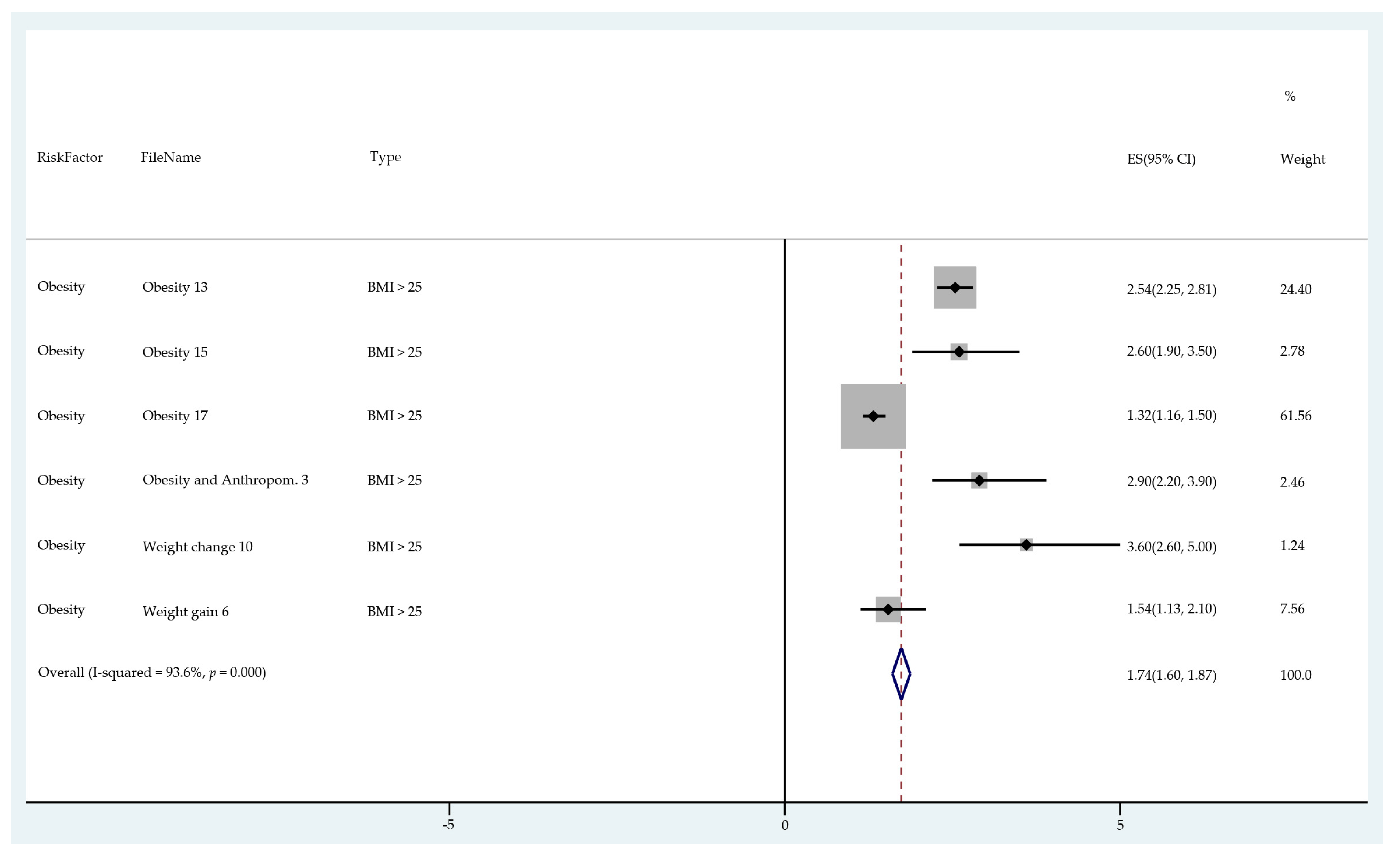
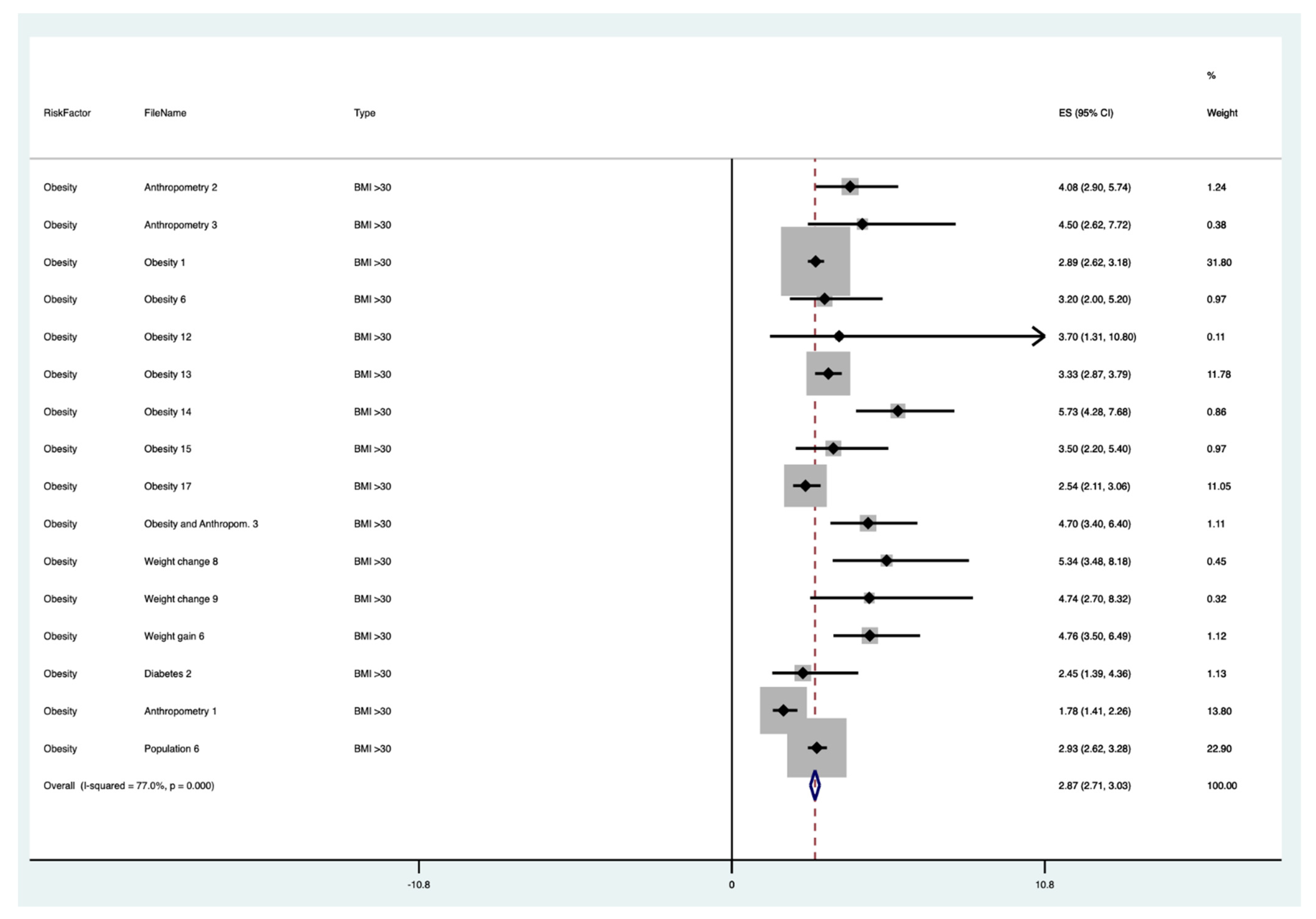

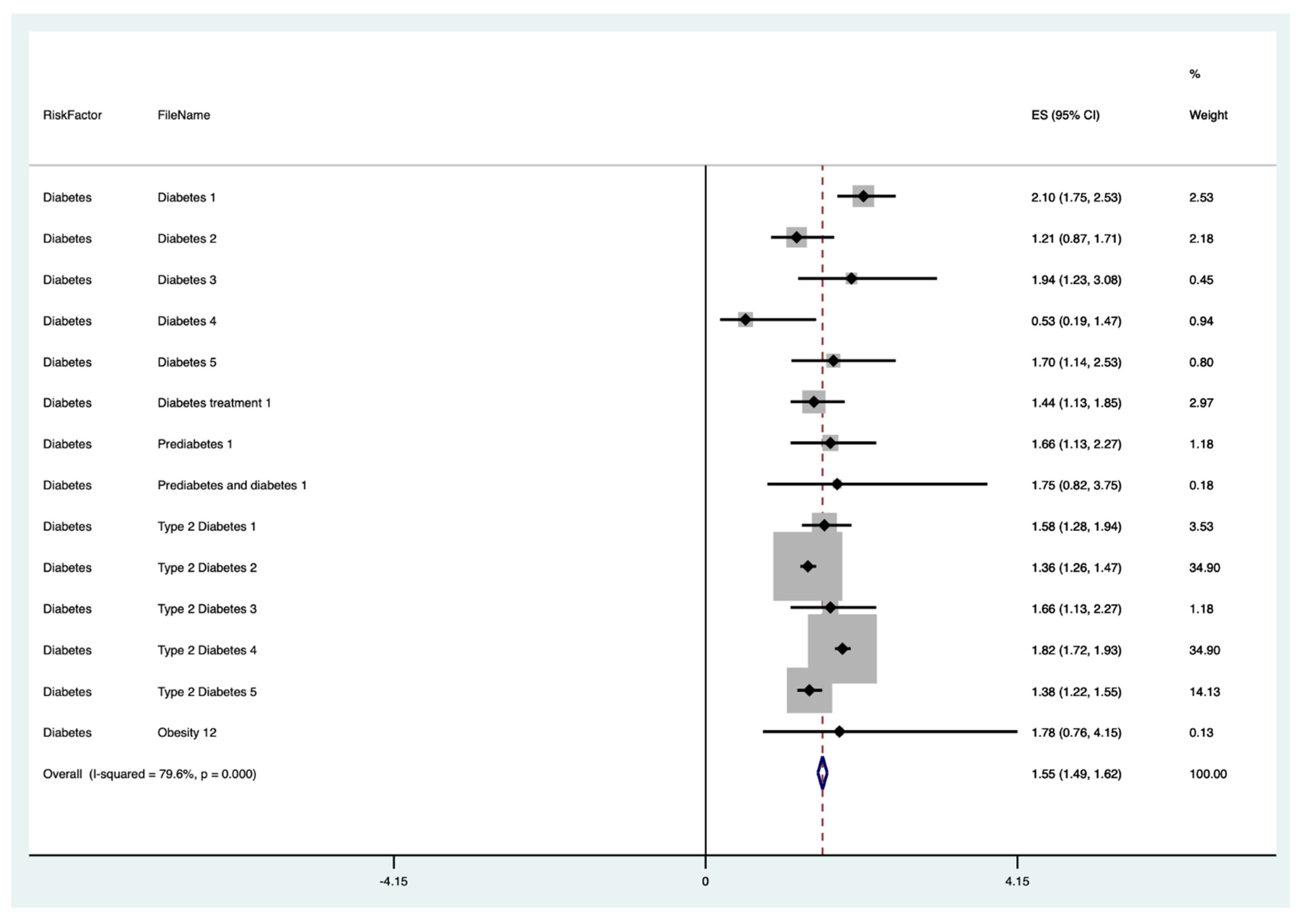

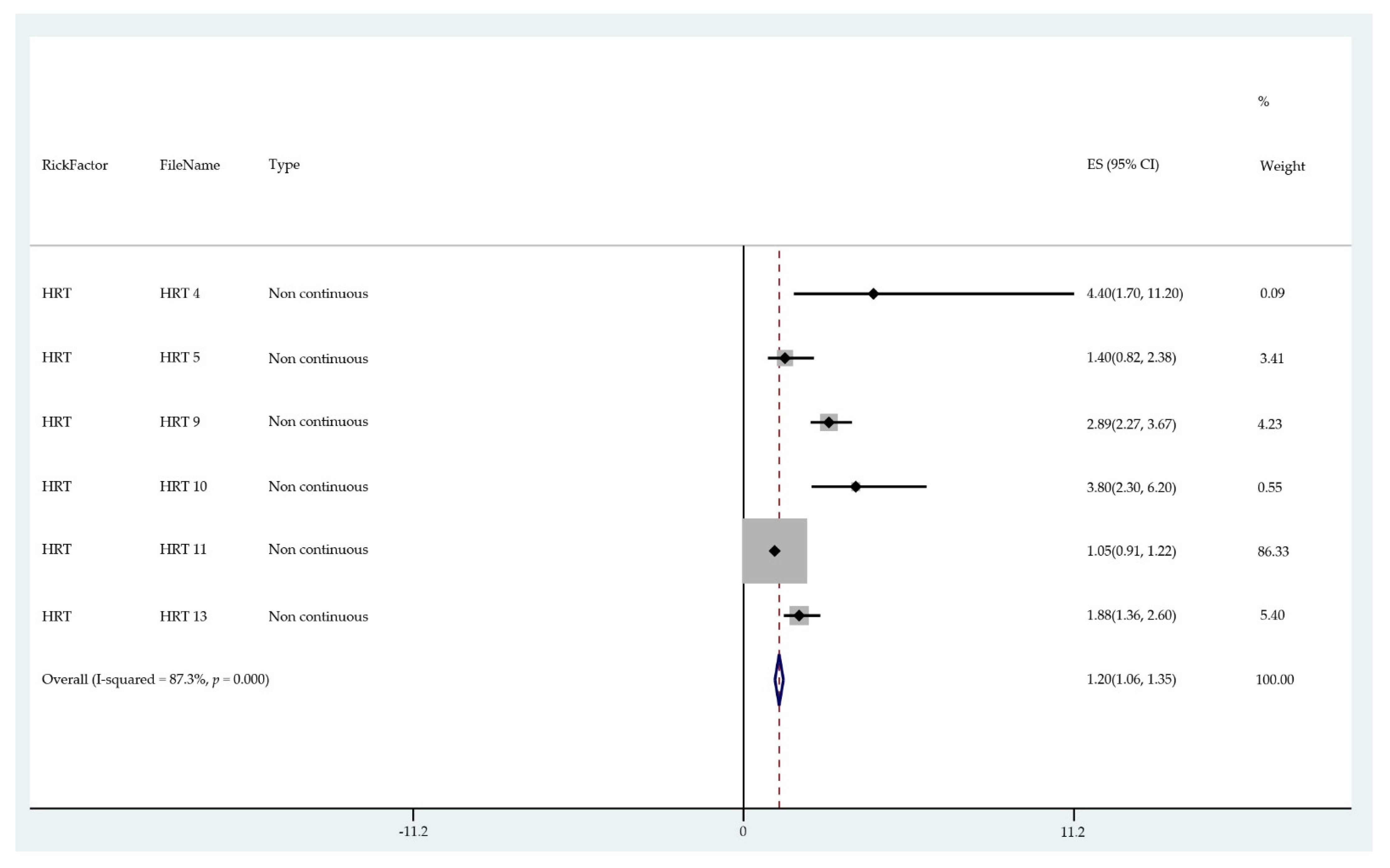
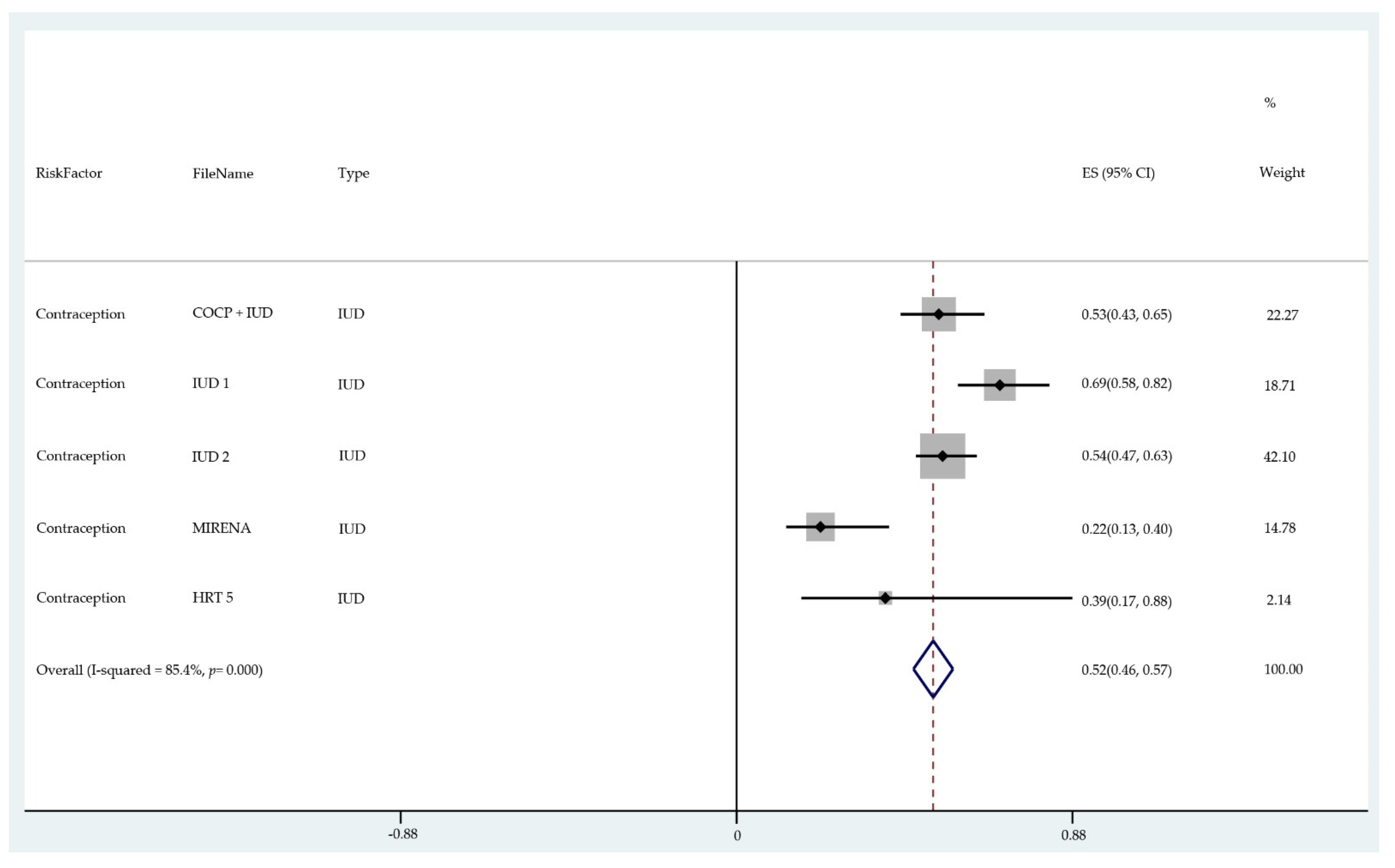
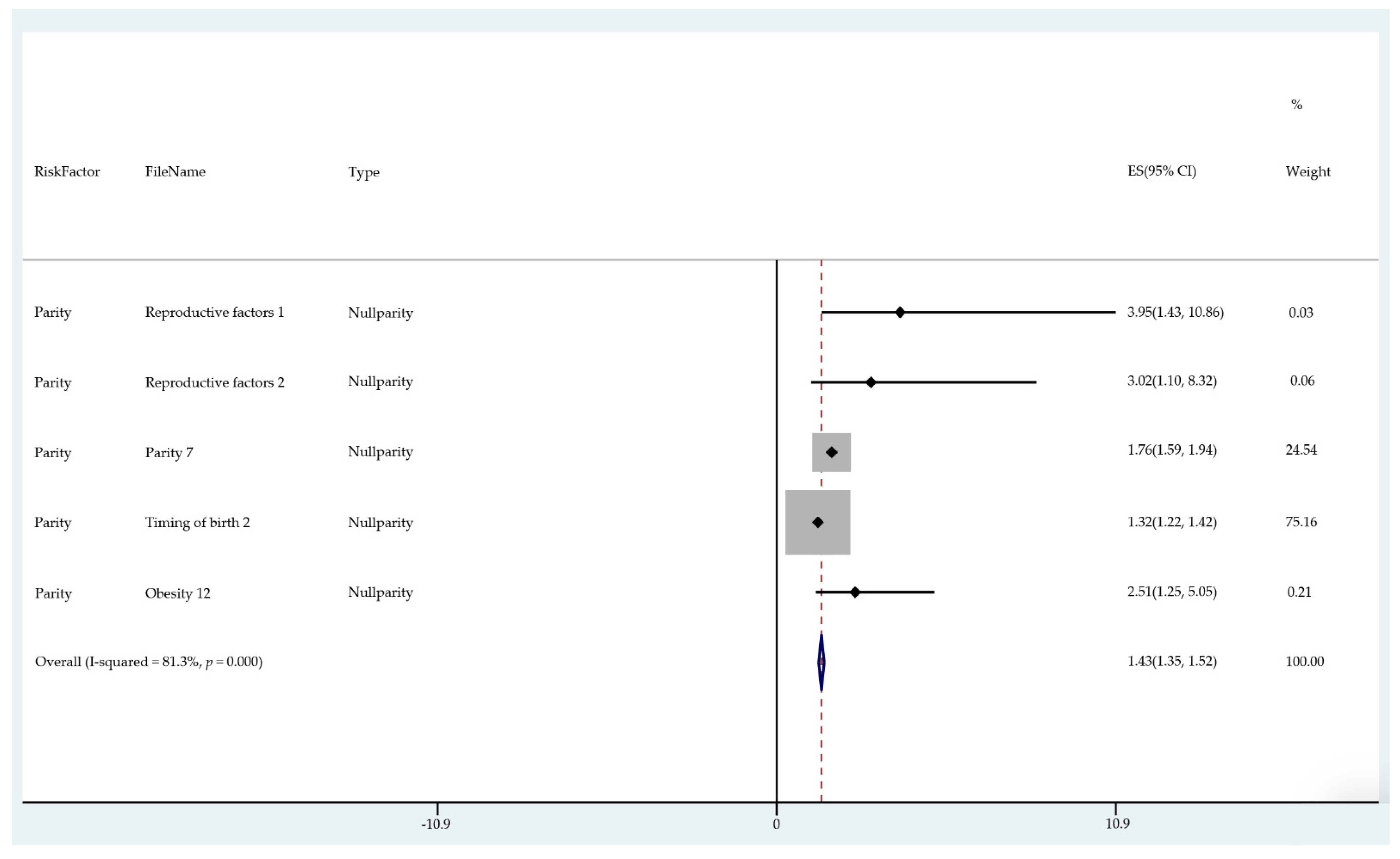
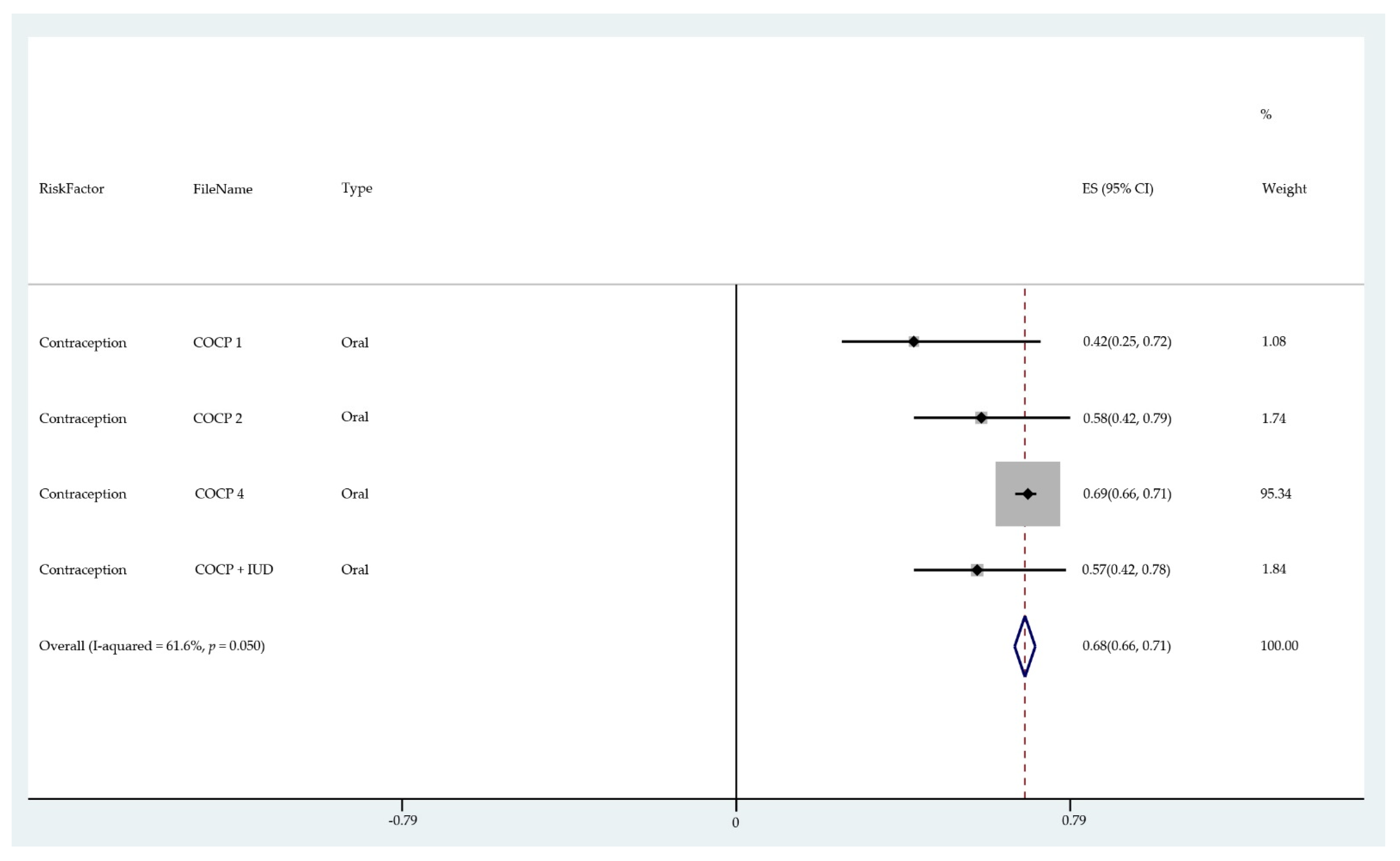
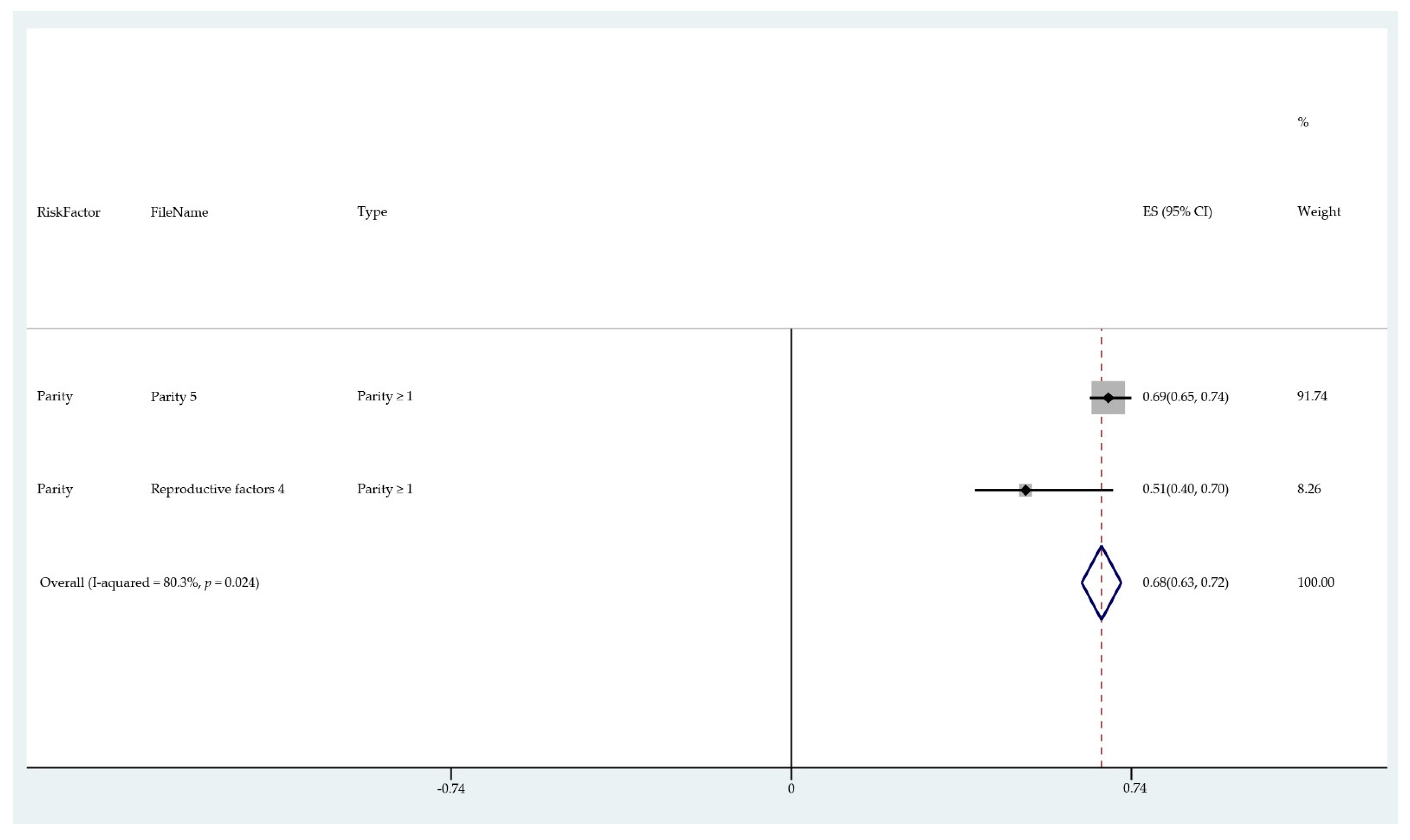
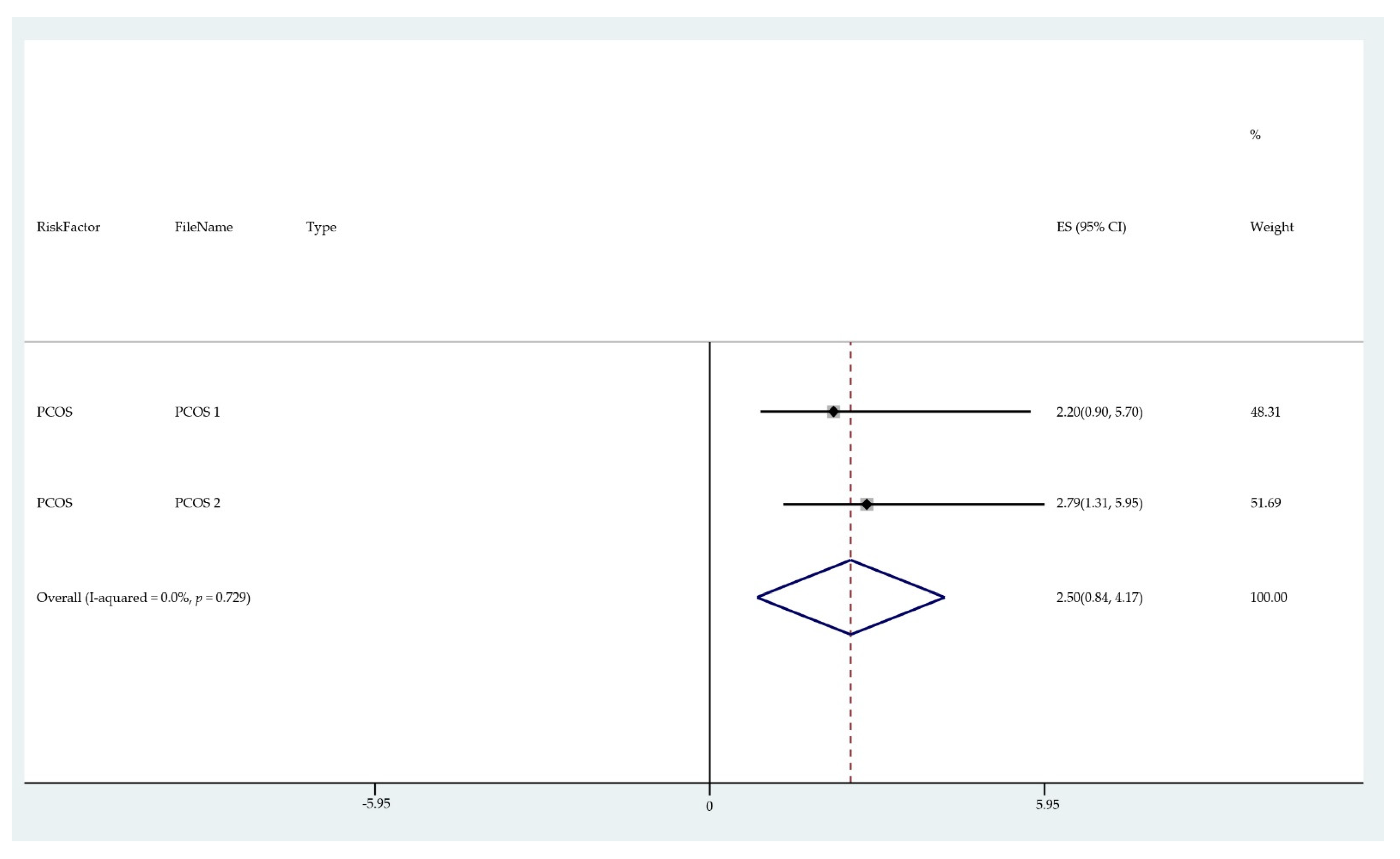

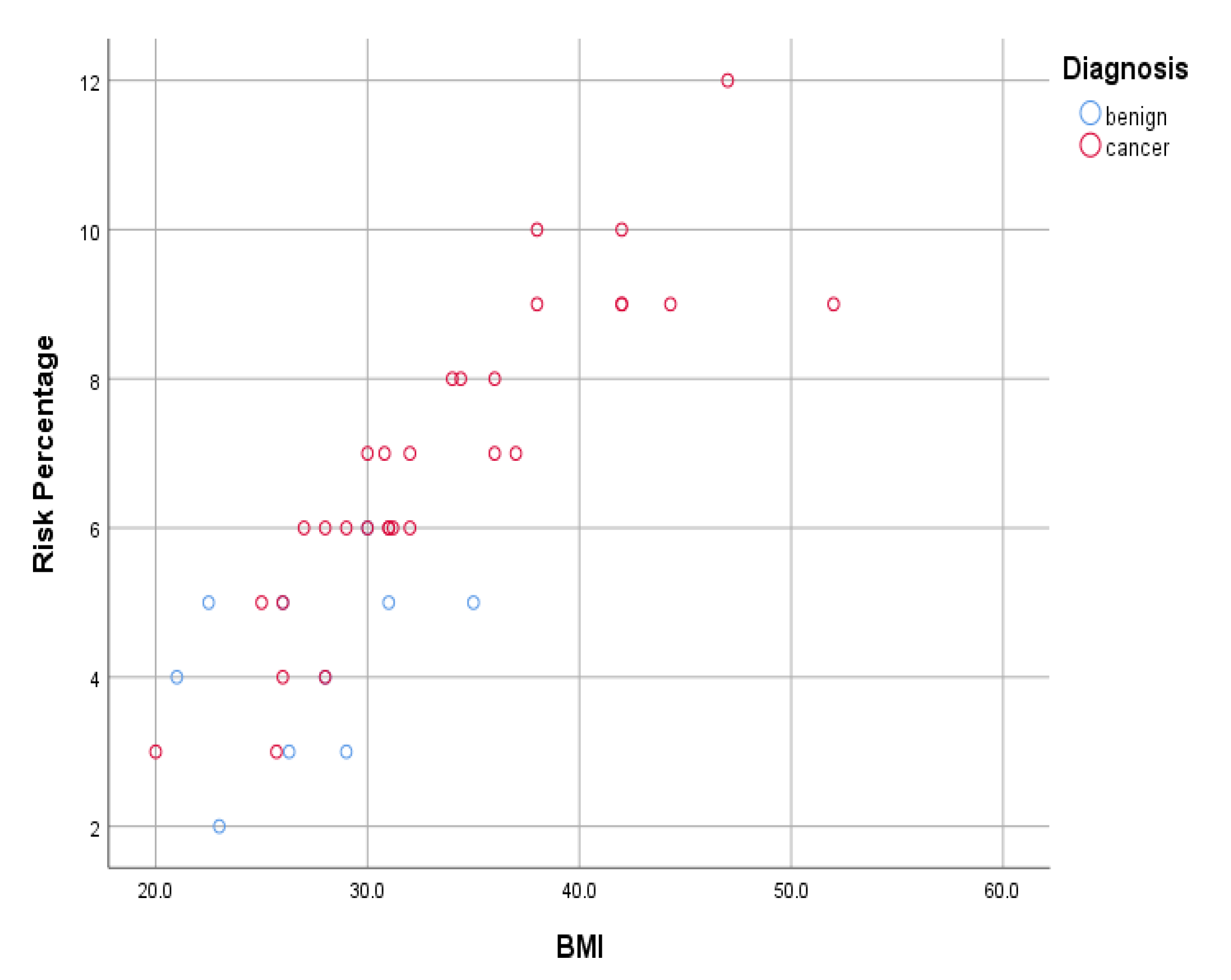
| Study Code Number | Reference |
|---|---|
| Obesity 13 | Jenabi, E., Poorolajal, J. (2015) [24] |
| Obesity 15 | Gao, Y. et al. (2016) [25] |
| Obesity 17 | Zhang, Y. et al. (2014) [26] |
| Obesity and anthropometry 3 | Xu, W.H. et al. (2005) [27] |
| Weight change 10 | Nagle, C.M. et al. (2013) [28] |
| Weight gain 6 | Lu, L. et al. (2011) [29] |
| Anthropometry 2 | Maso, L. et al. (2011) [30] |
| Anthropometry 3 | Schouten LJ et al. (2004) [31] |
| Obesity 1 | Reeves, G.K. et al. (2007) [5] |
| Obesity 6 | Jonsson, F. et al. (2003) [32] |
| Obesity 12 | Wise, M.R. et al. (2016) [33] |
| Obesity 14 | Rota, M. et al. (2015) [34] |
| Weight change 8 | Liu, Y. et al. (2016) [35] |
| Weight change 9 | Horn-Ross, P.L. et al. (2016) [36] |
| Diabetes 2 | Attner, B. et al. (2012) [37] |
| Anthropometry 1 | Friedenreich, C. et al. (2007) [38] |
| Population 6 | Yang, H.P. et al. (2012) [39] |
| Obesity 4 | Lindemann, K. et al. (2009) [40] |
| Diabetes 1 | Friberg, E. et al. (2007) [41] |
| Diabetes 3 | Friberg, E. et al. (2007) [42] |
| Diabetes 4 | Lindemann, K. et al. (2008) [43] |
| Diabetes 5 | Bosetti, C. et al. (2012) [44] |
| Diabetes treatment 1 | Luo, J. et al. (2014) [45] |
| Prediabetes 1 | Huang, Y. et al. (2014) [46] |
| Prediabetes and diabetes 1 | Lambe M et al. (2011) [47] |
| Type 2 diabetes 1 | Johnson, J.A. et al. (2011) [48] |
| Type 2 diabetes 2 | Lin, C.C. et al. (2014) [49] |
| Type 2 diabetes 3 | Oberaigner, W. et al. (2014) [50] |
| Type 2 diabetes 4 | Liu, X. et al. (2015) [51] |
| Type 2 diabetes 5 | Lo, S.F. et al. (2013) [52] |
| HRT 4 | Razavi, P. et al. (2010) [53] |
| HRT 5 | Jaakkola, S. et al. (2011) [54] |
| HRT 9 | Mørch, L.S. et al. (2016) [55] |
| HRT 10 | Doherty, J.A. et al. (2007) [56] |
| HRT 11 | Beral, V. et al. (2005) [19] |
| HRT 13 | Trabert, B. et al. (2013) [57] |
| COCP + IUD | Tao, M.H. et al. (2006) [58] |
| IUD 1 | Felix, A.S. et al. (2015) [59] |
| IUD 2 | Beining, R.M. et al. (2008) [60] |
| MIRENA | Jareid, M. et al. (2018) [61] |
| Reproductive factors 1 | Wernli, K.J. et al. (2006) [62] |
| Reproductive factors 2 | Xu, W.H. et al. (2004) [63] |
| Parity 7 | Yang, H.P. et al. (2015) [64] |
| Timing of birth 2 | Pfeiffer, R.M. et al. (2009) [65] |
| COCP 1 | Cook, L.S. et al. (2014) [66] |
| COCP 2 | Hannaford, P.C. et al. (2007) [67] |
| COCP 4 | Collaborative Group on Epidemiological Studies on Endometrial Cancer. (2015) [68] |
| Parity 5 | Wu, Q.J. et al. (2015) [22] |
| Reproductive factors 4 | Brinton, L.A. et al. (2007) [69] |
| PCOS 1 | Fearnley, E.J. et al. (2010) [70] |
| PCOS 2 | Barry, J.A. et al. (2014) [71] |
| Risk Factor | Type | Pooled Relative Risk | Percentage Risk |
|---|---|---|---|
| Contraception | IUD | 0.52 | −1.34% |
| Oral | 0.68 | −0.9% | |
| HRT | Continuous | 0.73 | −0.75% |
| Noncontinuous | 1.2 | 0.56% | |
| Parity | Nulliparity | 1.43 | 1.20% |
| ≥1 | 0.68 | −0.9% | |
| PCOS | Yes | 2.5 | 4.2% |
| No | 0 | 0% | |
| Diabetes | Yes | 1.55 | 1.54% |
| No | 0 | 0% | |
| Obesity (BMI) | <25 | 0 | 0% |
| ≥25 and <30 | 1.74 | 2.01% | |
| ≥30 and <40 | 2.87 | 5.24% | |
| >40 | 3.47 | 6.9% |
Publisher’s Note: MDPI stays neutral with regard to jurisdictional claims in published maps and institutional affiliations. |
© 2021 by the authors. Licensee MDPI, Basel, Switzerland. This article is an open access article distributed under the terms and conditions of the Creative Commons Attribution (CC BY) license (https://creativecommons.org/licenses/by/4.0/).
Share and Cite
Hutt, S.; Mihaies, D.; Karteris, E.; Michael, A.; Payne, A.M.; Chatterjee, J. Statistical Meta-Analysis of Risk Factors for Endometrial Cancer and Development of a Risk Prediction Model Using an Artificial Neural Network Algorithm. Cancers 2021, 13, 3689. https://doi.org/10.3390/cancers13153689
Hutt S, Mihaies D, Karteris E, Michael A, Payne AM, Chatterjee J. Statistical Meta-Analysis of Risk Factors for Endometrial Cancer and Development of a Risk Prediction Model Using an Artificial Neural Network Algorithm. Cancers. 2021; 13(15):3689. https://doi.org/10.3390/cancers13153689
Chicago/Turabian StyleHutt, Suzanna, Denis Mihaies, Emmanouil Karteris, Agnieszka Michael, Annette M. Payne, and Jayanta Chatterjee. 2021. "Statistical Meta-Analysis of Risk Factors for Endometrial Cancer and Development of a Risk Prediction Model Using an Artificial Neural Network Algorithm" Cancers 13, no. 15: 3689. https://doi.org/10.3390/cancers13153689
APA StyleHutt, S., Mihaies, D., Karteris, E., Michael, A., Payne, A. M., & Chatterjee, J. (2021). Statistical Meta-Analysis of Risk Factors for Endometrial Cancer and Development of a Risk Prediction Model Using an Artificial Neural Network Algorithm. Cancers, 13(15), 3689. https://doi.org/10.3390/cancers13153689








